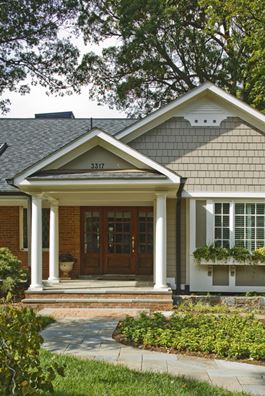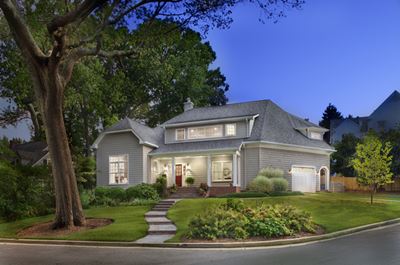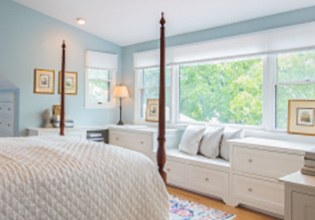How to Care for Your Period Style Home: Part 2
In part one of the three-part blog series about caring for your period home, I discussed roofing. In part two, I will be talking about gutters/downspouts and home foundations.

 The earliest homes had stone foundations and were often no more than cellars, not a basement as we know it. Although attractive, the stone foundation walls were often porous and seldom suited for creating a useable below-grade space. As construction methods improved and we moved into the early 1900s, 1920s, and 1930s, contractors began to use terra cotta blocks faced with brick or stucco—and still later, cement masonry units (CMUs) faced with brick or stucco.
Slowly, foundations became more substantial as engineering skills for home construction improved. Many bungalows, often kit houses, from the 1920s feature embossed foundation blocks meant to resemble rusticated cut stone. Wise historic homeowners will keep, repair, and restore their home’s original materials whenever possible.
Check back soon for the third and final part of this blog series!
The earliest homes had stone foundations and were often no more than cellars, not a basement as we know it. Although attractive, the stone foundation walls were often porous and seldom suited for creating a useable below-grade space. As construction methods improved and we moved into the early 1900s, 1920s, and 1930s, contractors began to use terra cotta blocks faced with brick or stucco—and still later, cement masonry units (CMUs) faced with brick or stucco.
Slowly, foundations became more substantial as engineering skills for home construction improved. Many bungalows, often kit houses, from the 1920s feature embossed foundation blocks meant to resemble rusticated cut stone. Wise historic homeowners will keep, repair, and restore their home’s original materials whenever possible.
Check back soon for the third and final part of this blog series!

Protecting the Integrity of Your Historic House
Gutters & Downspouts
If your gutters and downspouts are visible, and if they were originally copper, stick with copper or, at minimum, use bronze colored aluminum gutters and downspouts. If your house was built with half-round gutters and round downspouts, it is preferable to keep these same profiles the house was built with. More recent homes have what are called “ogee” shaped gutters and rectangular downspouts. If you have concerns about the capacity of your gutters and downspouts to capture rainwater, get the next size up in the same shape. Copper will outlast any homeowner, but depending on the age and style of your home, the shape, size, and materials of the gutters and downspouts will vary. There are occasionally built-in gutters integrated and concealed within the roof—these require careful maintenance and it is best to have them lined with copper to avoid leaking. In general, a roofer can advise you on the best gutters and downspouts.Foundations & Footings
Footings and foundations hold up your house and are the second most important aspect of caring for a period home. Whenever possible, make sure your foundations are not undermined by water runoff or improper excavation. Foundation subsidence causes expensive damage to a home such as crooked floors, doors that won’t shut, windows that don’t operate, and cracks in the walls and ceilings. A footing is defined as the bottom most portion of a foundation wall that distributes the load of the building onto the earth. A footing is usually a bit wider than a foundation wall. Historic homes seldom have what we today consider proper footings made of poured concrete. Victorian era foundations seldom used concrete foundations and were frequently an excavated trench with compacted earth. A single layer of brick a few inches wider than the foundation wall was laid over the dirt and held together with rather soft lime-based cement. This minimal footing acted as a base upon which a 12-inch-wide brick wall was constructed. Between row houses, it was called a “party wall” as well as front, back, and perimeter walls. In effect, it was a brick wall set on compacted earth. Late Victorian homes today might have minimal concrete footings. Knowing that your Victorian house has fragile footings means you should be wary about excavations—and if you must excavate a basement or crawl space, hire a structural engineer to plan and oversee the work.Stone, Terra Cotta Blocks & Cement Masonry Units
 The earliest homes had stone foundations and were often no more than cellars, not a basement as we know it. Although attractive, the stone foundation walls were often porous and seldom suited for creating a useable below-grade space. As construction methods improved and we moved into the early 1900s, 1920s, and 1930s, contractors began to use terra cotta blocks faced with brick or stucco—and still later, cement masonry units (CMUs) faced with brick or stucco.
Slowly, foundations became more substantial as engineering skills for home construction improved. Many bungalows, often kit houses, from the 1920s feature embossed foundation blocks meant to resemble rusticated cut stone. Wise historic homeowners will keep, repair, and restore their home’s original materials whenever possible.
Check back soon for the third and final part of this blog series!
The earliest homes had stone foundations and were often no more than cellars, not a basement as we know it. Although attractive, the stone foundation walls were often porous and seldom suited for creating a useable below-grade space. As construction methods improved and we moved into the early 1900s, 1920s, and 1930s, contractors began to use terra cotta blocks faced with brick or stucco—and still later, cement masonry units (CMUs) faced with brick or stucco.
Slowly, foundations became more substantial as engineering skills for home construction improved. Many bungalows, often kit houses, from the 1920s feature embossed foundation blocks meant to resemble rusticated cut stone. Wise historic homeowners will keep, repair, and restore their home’s original materials whenever possible.
Check back soon for the third and final part of this blog series!







